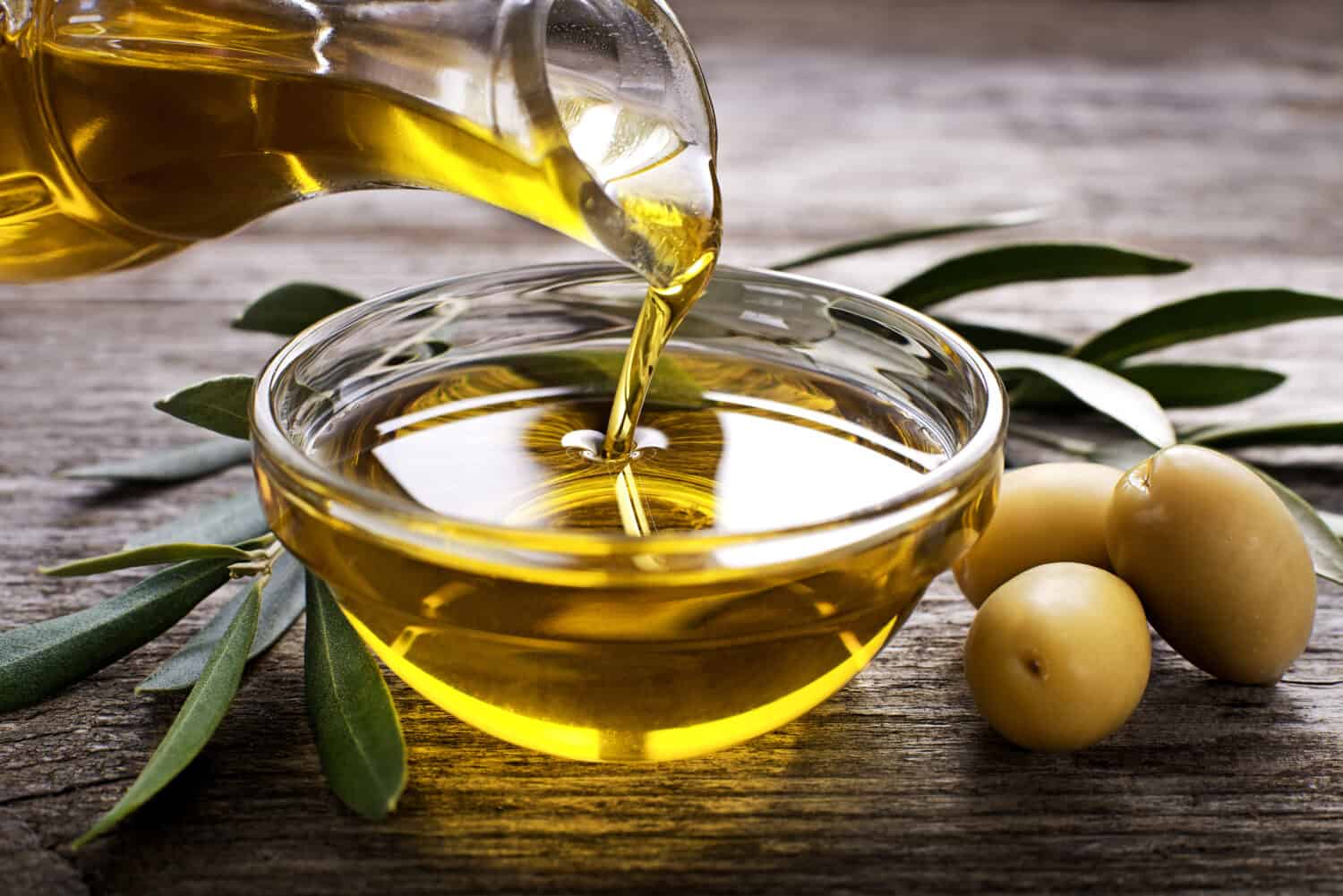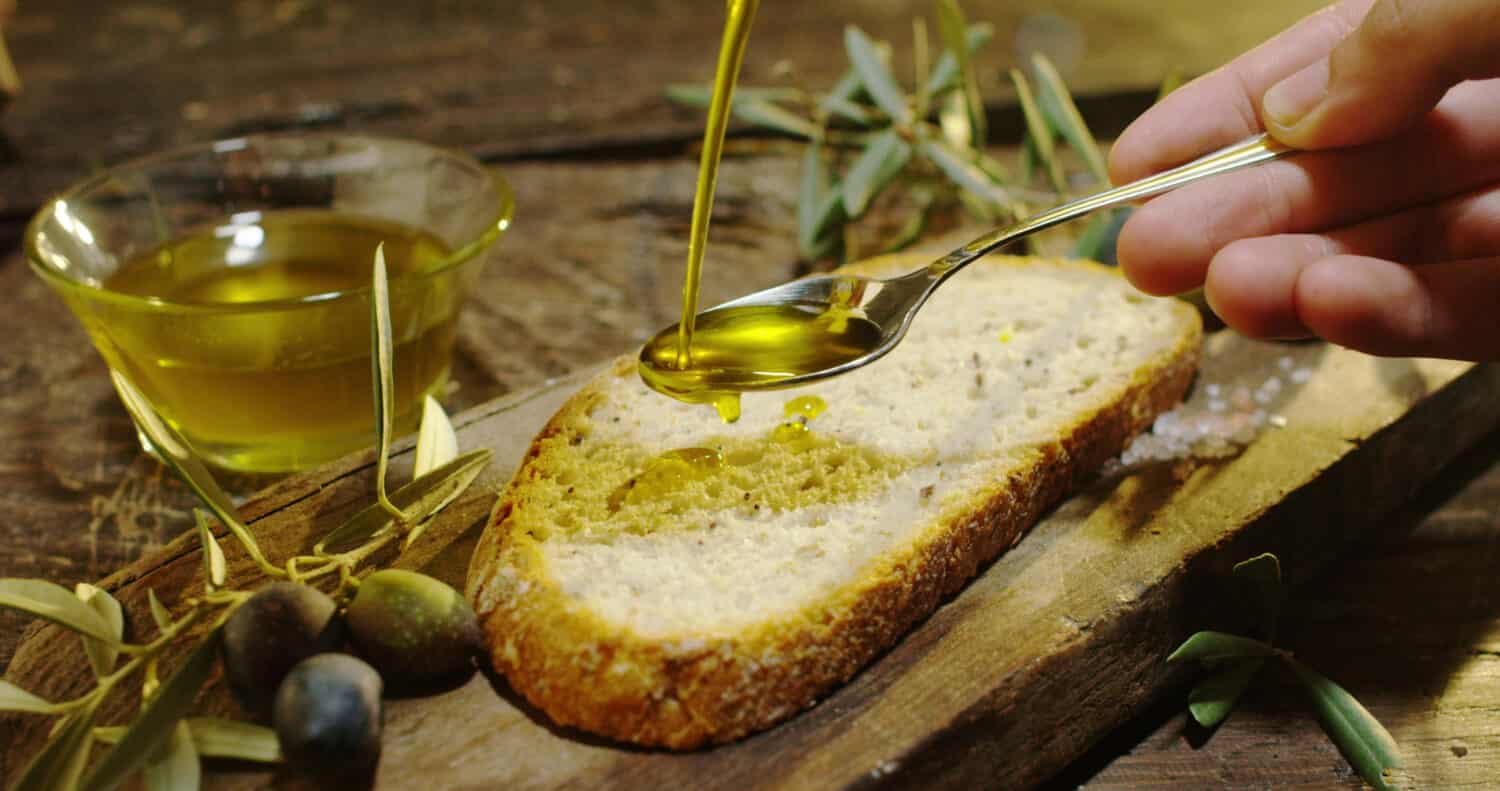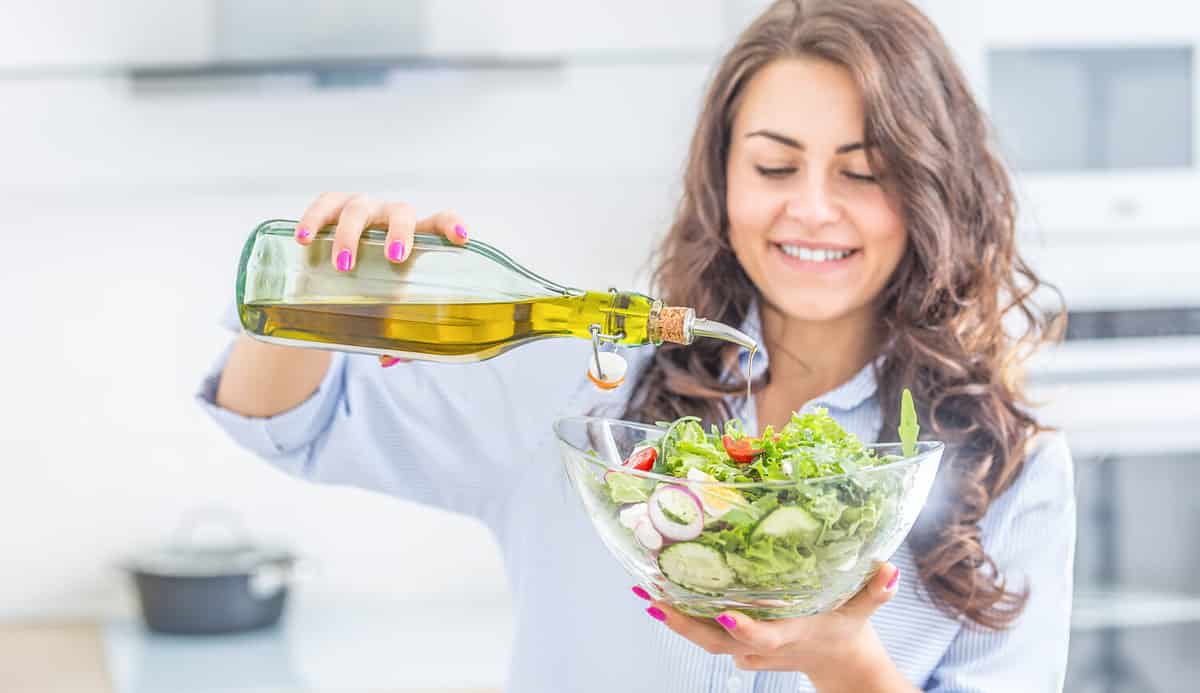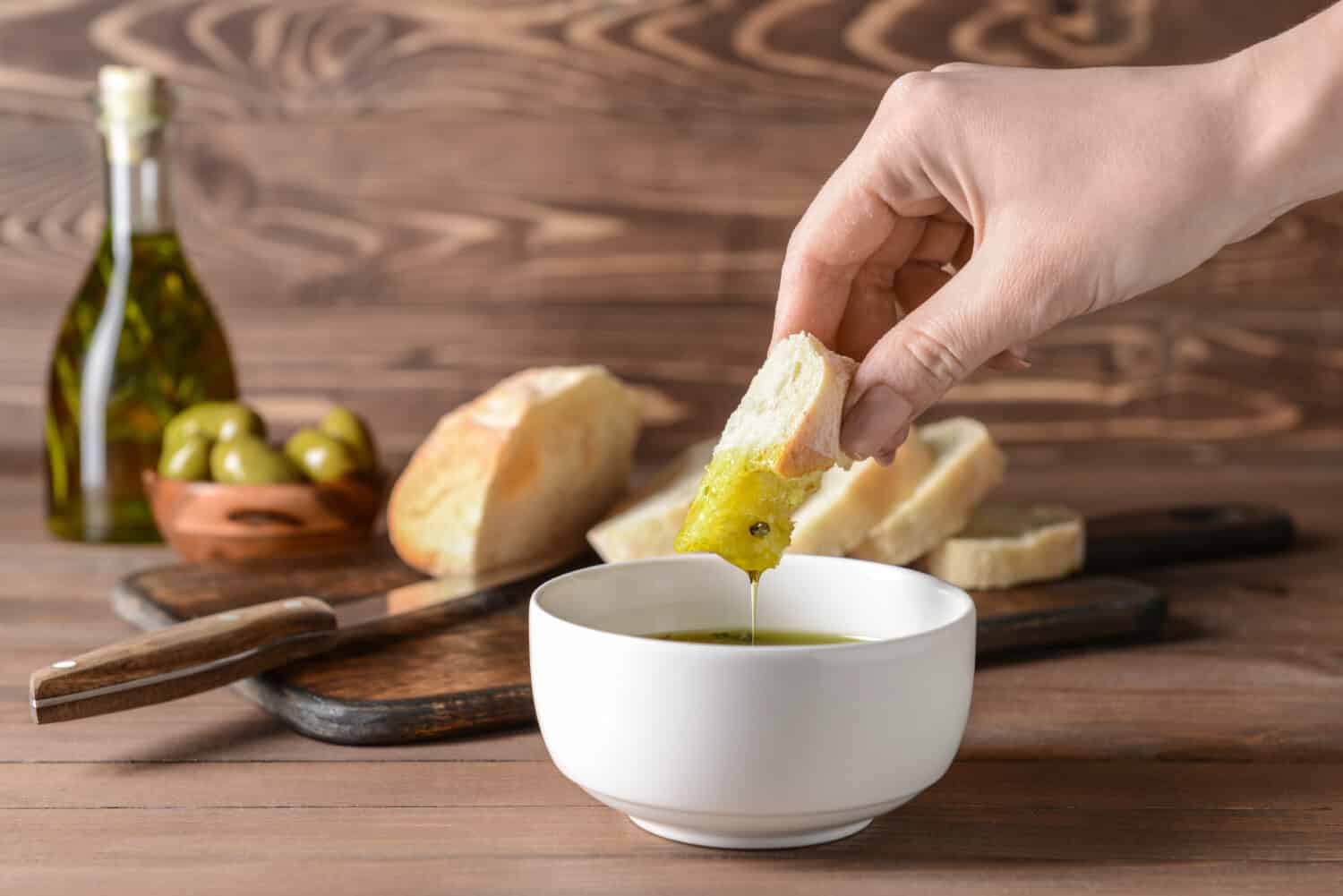There’s a reason the Mediterranean Diet is a frequent go-to for those looking to adopt a healthy eating plan. While the diet’s popularity can likely be attributed to a number of different factors, the star of the show is none other than olive oil. Used in everything from pasta sauces to soothing cracked skin (it can even help remove gum from hair!), olive oil’s advantages appear to be endless. A basic staple item in most of our kitchens or pantries, it’s so commonplace that we tend not to give it a second thought. But what exactly are olive oil’s health benefits? And are there any disadvantages? We’re breaking down its uses, flavor profiles, and the science behind how it affects our bodies.

©DUSAN ZIDAR/Shutterstock.com
What is Olive Oil, and Where Does it Come From?
You‘re likely already familiar with what olive oil is and the basics of how it’s made. But for argument’s sake, we’ll dive in anyway. Olive oil is made by pressing or macerating whole olives into a pulp. The oil that comes out is then collected and put through a filtration process to remove impurities.
If you’re curious about where most of the world’s olive oil comes from, the answer can be found in the Mediterranean region. It has been cultivated there for over 5,000 years! Spain is the largest producer of olive oil by a landslide. (This is followed by Italy and Greece). Spain can also be credited with bringing olive oil to the United States — missionaries brought olive trees to California back in the 18th century, planting them along the coast and spreading production to other agricultural areas.
It’s important to note that there are, generally speaking, three types of olive oil — extra virgin, virgin, and refined. Those designations are given based on the amount of processing each one goes through prior to being bottled up and distributed for sale. Here are the three olive oil types broken down a bit more.
- Extra virgin olive oil: Often abbreviated to EVOO, extra virgin olive oil is widely regarded as the healthiest of the olive oils. It is the primary source of fat in the Mediterranean diet, in fact. It goes through the least amount of processing, so it contains a higher number of the plant nutrients that aid in preventing cardiovascular disease and cancer. According to the American Heart Association, extra virgin olive oil is the fatty portion of olive juice that is removed using mechanical and physical processes. This unrefined quality is what renders it healthier. If you've ever seen olive oil labeled as “first-pressed” or “cold-pressed,” that's an indication that the product is unrefined and natural — that it only underwent a solitary milling process.
- Virgin olive oil: If olive oil has only minor impurities and an acidity level that ranges between 0.8 and 2.0, it is labeled as “virgin olive oil.” To make virgin olive oil, extraction is done solely by mechanical means, whether through a centrifuge or via a traditional pressing method. Virgin olive oils are never subject to heat.
- Refined olive oil: Preserving fewer of the healthy nutrients than virgin or extra virgin olive oil, refined olive oil doesn't have the health benefits of its counterparts. However, it is less chemically modified than oils like vegetable oil. Technically speaking, olive oil is considered refined when it undergoes added processing — such as bleaching — that balances out imperfections. It is typically also combined with extra virgin olive oil. The result of all of these factors is a lighter flavor.
What Does Olive Oil Taste Like, and What is it Used For?
Of course, olive oil tastes like olives — no surprise there. But believe it or not, there is a wide range of flavor profiles, from herbal to peppery to buttery. Much like wine, high-quality olive oil can run the gamut in terms of taste. A true connoisseur might easily be able to distinguish between regions — an olive oil from Spain versus one from Italy, for example.
When it comes to baking and cooking, we can typically sub olive oil for ingredients such as butter or margarine. As a fat source substitute, it offers an option with lower cholesterol. However, its uses extend far beyond being a mere substitute. Here are a few of them:
- Frying or sautéeing food.
- Baking
- Preserving proteins or vegetables, such as sardines, tuna, anchovies, garlic, sundried tomatoes, mushrooms, ginger, and more.
- As the foundation for a dip or salad dressing
- Drizzling over a finished dish such as hummus or soup.
- Conditioning or polishing wooden cutting boards and utensils.
- Removing gum from hair.
- Rehydrating hair or taming flyaways.
- Soothing dry or cracked skin.
- Soothing rashes — even diaper rash.
- Unjamming stuck zippers.
- Keeping hinges from squeaking.
The list goes on. Have you discovered any uses for olive oil that might surprise us?

©Kitreel/Shutterstock.com
What are the Health Benefits of Olive Oil?
Olive oil’s main claim to fame when it comes to health benefits tends to be its effects on our cardiovascular system — studies have clearly shown that more extra virgin olive oil in our diet directly equates to better heart health, such as lowering our risk of heart disease and blood pressure. But its benefits don’t stop there.
One of the most popularly quoted studies on olive oil, led by Harvard Medical School, states that we can credit the health benefits of olive oil to its antioxidant and anti-inflammatory properties. Moreover, observational studies apparently offer up a connection between olive oil and a lower risk of some cancers (such as colorectal, pancreatic, prostate, endometrial, and breast cancers). Studies even suggest a lower risk of Alzheimer's and dementia in those who consume higher amounts of olive oil. Studies also show that it can help fight harmful bacteria and lower your risk of stroke. Additionally, drinking small amounts of olive oil can soften your stool and combat constipation. In general, research proves that consuming more than half of a tablespoon of olive oil daily has an effect on your overall wellness!
What are the Health Downfalls of Olive Oil?
While olive oil boasts an extensive number of health benefits, it’s also true that there are a few downsides. Namely, over-consumption of olive oil can cause skin side effects such as acne or rashes along with allergic reactions. Research suggests that diarrhea, nausea, and inflammation are also possible.

©Marian Weyo/Shutterstock.com
Important Takeaways
- Olive oil is made by pressing or macerating whole olives into a pulp. After that, it is put through a filtration process.
- Olive oil has a range of flavor profiles.
- The majority of the world's olive oil comes from Spain, followed by Italy and then Greece.
- Olive oil has three grades: Extra virgin olive oil (EVOO), virgin olive oil, and refined olive oil.
- Olive oil is a huge source of antioxidants. It can also boost your brain and heart health, fight inflammation, lower your risk of stroke, and aid your immune system. Additional research suggests it prevents dementia and cancer and combats constipation.
- Olive oil has many uses outside of the culinary world, including soothing dry skin, conditioning wood, hair care, and lubricating hinges.
- Everything in moderation — even olive oil! Consuming excess amounts can lead to acne, skin rash, allergies, diarrhea, and even nausea.
Up Next:
- Vegetable Oil vs. Olive Oil in Baking: Major Differences, Nutritional Profile, Function in Baking & Substitutes
- Extra Virgin Olive Oil vs. Olive Oil: Taste Differences & Which is Healthier
- Canola vs. Olive Oil: The Good, Bad, & Ugly
The image featured at the top of this post is ©Pixel-Shot/Shutterstock.com.
